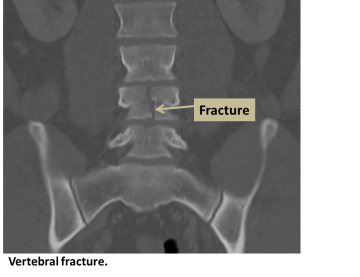Vertebral Fracture
Find your care
Our board-certified physicians diagnose and treat many vascular conditions. Call 310-481-7545 to learn more about interventional radiology services.
What are vertebral fractures?
Vertebral fractures are fractures of the vertebrae, or bones that make up the spine. There are many different types of fractures, and they can be caused by car accidents, falls, other trauma, and osteoporosis. Vertebral fractures caused by weakened bone tend to be in the lower back because those vertebrae support the most body weight. One function of vertebrae is to protect the spinal cord, and damage to the vertebrae could damage the spinal cord as well. There are also many blood vessels and nerves surrounding the vertebrae, so vertebral fractures often cause pain.

Risk Factors
Although trauma can cause unexpected vertebral fractures, some factors that weaken bone and make you more susceptible to fractures include:
- Osteoporosis, which has its own risk factors including but not limited to
- Increased age
- Female
- Hormone levels
- Diet low in calcium
- Long-term steroid use
- Degenerative disk disease
- Bone tumors, either those that originate in the bone or metastasized (spread) from another tumor
- Tumors affecting the spinal cord
- Infections affecting the vertebrae and intervertebral disks
Symptoms
Some fractures, especially those resulting from weakened bone, may initially be asymptomatic. Over time, symptoms from vertebral fracture alone include:
- Severe, sharp back pain, more common in the lower back
- Decreased height
- Tenderness in back muscles near the fracture
- Kyphosis, an excessive spine curvature that creates a hump back
If there is any damage to the spinal cord, additional symptoms will vary depending on the location of the damage.
Diagnosis
The physician will perform a physical exam and ask about the above risk factors. To look for the fracture, the physician may also request:
- X-ray
- MRI
- CT scan
- DEXA or DXA scan (measures bone density)
Treatments
The interventional radiologist uses continuous x ray imaging to guide a needle through the skin overlying the fractured spinal vertebra. A medical bone cement is injected into the body of the fractured vertebra. The cement hardens within 15 minutes and acts to provide internal stability to the fracture and prevent further collapse.
For More Information:
For more information or to schedule an appointment with one of our IR physicians, please call 310-481-7545.